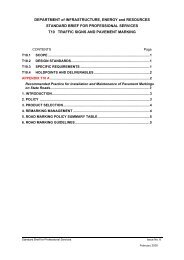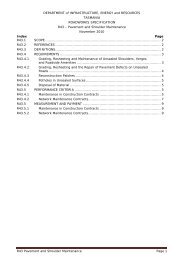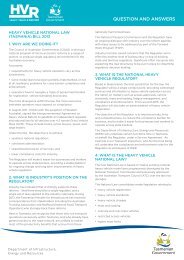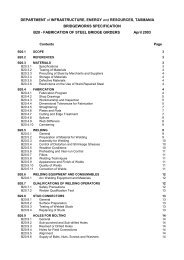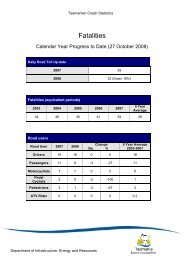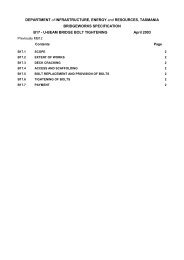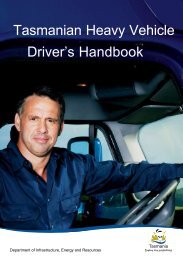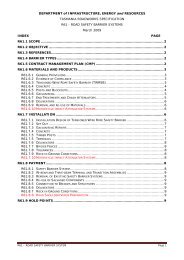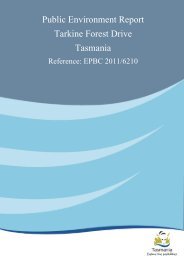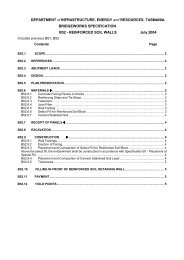Tasmanian Older Drivers' Handbook - Transport
Tasmanian Older Drivers' Handbook - Transport
Tasmanian Older Drivers' Handbook - Transport
- No tags were found...
You also want an ePaper? Increase the reach of your titles
YUMPU automatically turns print PDFs into web optimized ePapers that Google loves.
<strong>Tasmanian</strong> <strong>Older</strong>Drivers’ <strong>Handbook</strong>DepartmentDepartmentof Infrastructure,businessEnergyunitand Resourcesname here
AcknowledgementsThis publication draws on: Keeping moving - The positive guide formature road users. The NZ <strong>Transport</strong> Agency’s assistance isgratefully acknowledged. The Department of Infrastructure, Energyand Resources has adapted the NZ <strong>Transport</strong> Agency’s version to<strong>Tasmanian</strong> requirements.The production of this publication has been made possible byfunding from MAIB.This handbook is owned and maintain by the Department ofInfrastructure, Energy and Resources. Any requests to reproduceinformation or diagrams contained in the <strong>Tasmanian</strong> <strong>Older</strong> Drivers’<strong>Handbook</strong> must be made in writing to the Department.This publication incorporates information to help older drivers drivesafely and responsibly in Tasmania. It does not contain all of thelaws relating to licensing in Tasmania.While every effort is made to ensure that the information is accurateand conforms to <strong>Tasmanian</strong> legislation, this publication must not beconstrued as a legal interpretation of legislation.All enquiries regarding this publication should be directed to the<strong>Transport</strong> Enquiry Service on 1300 851 225 or the Department ofInfrastructure, Energy and Resources, GPO Box 1002, Hobart,Tasmania, 7001.Version 1 - October 2011i<strong>Tasmanian</strong> <strong>Older</strong> Drivers’ <strong>Handbook</strong>
<strong>Tasmanian</strong> <strong>Older</strong> Drivers<strong>Older</strong> drivers are under-represented in crash statistics because theygenerally:• are safe and cautious, less likely to speed and usually maintainsafer following distances• don’t tend to engage in risk taking behaviour such as drink-driving• are very good at assessing their own driving skills, and have themeans to choose when and where to drive within their limits, andwhen to cease driving.The <strong>Tasmanian</strong> Government is committed to helping older<strong>Tasmanian</strong>s retain their independent mobility by whatever meansthey choose, for as long as possible. To support this, it has removedmandatory driving assessments for drivers aged 85 and over.This guide provides information on the driver licensing processes andtips to help you keep moving. It also contains guidelines forassessing your own driving ability and resources to help you planahead in case you need to give up driving for any reason.<strong>Tasmanian</strong> <strong>Older</strong> Drivers’ <strong>Handbook</strong> 1
Contents<strong>Tasmanian</strong> <strong>Older</strong> Drivers 1Keeping moving by car 3Assessing your driving skills 4Prolonging your driving career 61. A clear vision 62. Maintain control 63. Choosing a car 74. Maintaining your car 75. Stay alert 106. Avoid fatigue 107. Refresh your knowledge 11Medical conditions and medication 18Medical conditions and driving 18Medications 22Licensing 24From age 65 24From age 75 24What happens next? 25Concerns about someone’s driving 28Life beyond driving 29Moving house? 30Sharing the load 30Home delivery services 30Keeping moving – by public transport 31Keeping moving – on foot 32Stay safe while walking 32Keeping moving – by bike 33Keeping moving – by mobility scooter 34Finding out about alternative transport schemes 35Taxis 35Community <strong>Transport</strong> 35Useful contacts 36Service Tasmania shops 37i<strong>Tasmanian</strong> <strong>Older</strong> Drivers’ <strong>Handbook</strong>
Keeping moving by carMost older <strong>Tasmanian</strong>s rely on their car to get around – for shopping,appointments or visiting friends and family. Maintaining mobility inlater life also helps to delay the physical and mental declineassociated with ageing.Driving is a complicated task, requiring continuous concentration andgood health. Ability, not age, determines whether you are a safedriver. <strong>Older</strong> drivers as a group are very safe and responsible drivers– most have years of driving experience and a good driving record.However, it’s important to remember that the ageing process canaffect a range of skills essential to driving – including eyesight,memory, decision-making and reaction times. Moreover, in the eventthat you are involved in a crash, the older you are the more likely youare to be killed or injured – due to increasing physical fragility.It is important for all drivers, regardless of age, to regularly andhonestly assess their own driving capabilities to keep themselvesand others safe.<strong>Tasmanian</strong> <strong>Older</strong> Drivers’ <strong>Handbook</strong> 3
Assessing your driving skillsDrivers who accurately assess their driving skills are more likely toadjust their driving habits and stay safe on the road for longer.Your doctor will regularly check whether you are medically fit to drive.However, it’s your responsibility to ensure your driving skills andknowledge are up to scratch every time you drive – and if they arenot, to take action to address any problem.You should regularly ask yourself these questions:Are you having trouble seeing signs, road markings, kerbs,medians, other vehicles or pedestrians, especially at night?Do you find it difficult to shift your focus from near to far objects?Are you having trouble turning your head or looking over yourshoulder to check for traffic?Do you have trouble moving your foot from the accelerator to thebrake pedal, or turning the steering wheel?Do your joints ache after even a short drive?Do you have trouble reversing?Is it getting harder to judge gaps in the traffic when merging orturning at intersections?Does your mind sometimes wander when you drive?Do you sometimes feel overwhelmed by the traffic environment,particularly when turning at intersections?Are you sometimes confused as to who should give way?Have you found yourself driving too slowly and holding up traffic?Have you recently been ‘honked’ at by other motorists?Are you missing (or reacting more slowly to) unexpectedhazards, such as pedestrians crossing the road?Are you feeling more tired while driving – even on short trips?Are you having trouble judging distance, resulting in a smallcollision in the carpark or with the mailbox?Have you had a near miss or actual crash in the last three years?Has a friend or family member recently said they are worriedabout your driving?Do you sometimes get lost on familiar routes?Has your doctor suggested you limit your driving or think aboutstopping driving altogether?4 <strong>Tasmanian</strong> <strong>Older</strong> Drivers’ <strong>Handbook</strong>
If you answered ‘yes’ to some of the above questions, it’s notnecessarily a sign that it’s time to give up driving. But it may indicateareas where you need to take action to avoid endangering yourselfor other road users – particularly if you answered ‘yes’ to any of thelast five questions.If in doubt:• talk to others who are in a similar situation to you• listen to the people who know you best and careabout you most• discuss your driving with your doctor.Many mature drivers adjust their driving or use additional vehiclefeatures to compensate for any weaknesses (see the followingsection for ideas).A full medical fitness to drive assessment conducted by a doctor isstill the best way to determine if you are safe to continue driving.If you drive a public passenger vehicle such as a bus or taxi,safe driving is even more important because when you driveyou’re responsible for your passengers’ safety on the road aswell as your own. It is especially important for you to regularlyassess your driving ability.<strong>Tasmanian</strong> <strong>Older</strong> Drivers’ <strong>Handbook</strong> 5
Prolonging your driving careerMany older drivers compensate for the effects of ageing through theuse of various coping strategies. For example, they might avoiddriving at night, during busy traffic times or in bad weather, or theymay decide to drive only in familiar areas. They might only use thecar for essential trips – or choose to drive with a companion.The following are some other suggestions to help you keep drivingsafely.1. A clear vision• If you need glasses or contacts for driving, make sure you alwayswear them and that the prescription is current.• Don’t wear sunglasses or tinted glasses at night, unless they areprescription glasses.• Drive during the day where possible.• Keep the windscreen, mirrors and headlights clean.• If possible, choose a car with larger dials on the instrument paneland make sure they are bright enough for you to see them clearly.• Have regular vision check-ups with your optometrist.2. Maintain controlDiminished strength, coordination and flexibility can significantlyaffect your ability to safely control your vehicle.If you’re finding it difficult to turn your head or reach controls:• see your doctor for advice about exercise and/or physiotherapy oralternative treatments• see an occupational therapist about specialised equipment tomake it easier to steer and operate the foot pedals.If you are worried that your health may be affecting your ability todrive safely, talk it over with your doctor. They may also be able toadvise you on other ways to keep fit to drive. You can ask a familymember or friend to go to the doctor with you.6 <strong>Tasmanian</strong> <strong>Older</strong> Drivers’ <strong>Handbook</strong>
3. Choosing a carWhen buying a car choose:• the newest model you can afford - generally the newer the car, themore safety features it has• an automatic transmission with features such as power steeringand an anti-lock braking system (ABS)• a car that enables you to sit higher above the road, allowing you tomore easily swing your legs in and out• a car with larger side mirrors and adjust them to reduce the driver’sside blind spot. Special rear-view mirrors are also available tocover blind spots• a car with a good safety rating - you can find car safety ratings atwww.howsafeisyourcar.com.au.If your car is fitted with an airbag, sit at least 25 centimetres (or about1 foot) from the steering wheel to reduce the chances of injury fromthe airbag during a crash.4. Maintaining your carIt’s important to keep your car in good condition. Have it servicedregularly, and ask the mechanic to do a quick safety check for you.If anything out of the ordinary happens to your car – strange noises,rattling etc, then have it checked out. Don’t wait until it creates adangerous situation. An early check can often help you save onexpensive repairs.If your car had particular equipment when it was first registered, thenthat equipment should still be there and operating. For example, ifthere was a left side mirror and it falls off, it needs to be replaced.Here are some simple safety checks you can do yourself, as well ashaving regular servicing and inspections by a mechanic.LightsBurned out light bulbs are not always easy to detect from the driver’sseat but they can be a serious traffic hazard.You can check your lights with someone else standing in front andbehind the car to check that they all work. Regularly clean dirt anddust off all lights.A broken indicator is usually identified by a marked change in theflashing speed of the turn signal indicator. No flashing at all may also<strong>Tasmanian</strong> <strong>Older</strong> Drivers’ <strong>Handbook</strong> 7
indicate a defective flasher unit.If other people flash their lights at you at night when you are usingyour low beam head lights, this probably means that your head lightsare aimed too high. Your head lights should be tested by a mechanicor at your local garage and properly adjusted.TyresIn your car owner manual you should find the recommended tyrepressure for the tyres on your car. A tyre should hold its pressure forabout three months. If you find that your tyres are losing pressuremore frequently than this:• Check that the valve caps are in place and are screwed downfirmly• Take your car to a garage and get the tyres checked. You mayneed new tyresRemember when checking the pressure in your tyres to also checkyour spare tyre.There needs to be clear and visible tread on all parts of the tyre thatmeet the road. Your tyres should be free from cuts, gouges, cracksand bulges. Regularly check your tyres at least once a week toensure treads are at a safe level, evenly worn, and have no nailsembedded in them or other damage.Replace worn or damaged tyres because they are very likely to getpunctures, and are particularly dangerous in wet and slipperyconditions.8 <strong>Tasmanian</strong> <strong>Older</strong> Drivers’ <strong>Handbook</strong>
BrakesBrakes are essential for safety. However they are very easilyoverlooked when checking your car.To check brakes, turn the engine off, press the brake pedal as hardas you would if you had to stop suddenly in traffic and hold thepressure for thirty seconds. The brake pedal should not noticeablysink towards the floor. If it does, consult a mechanic.To check power-assisted brakes, turn the engine off and tap thebrake pedal several times to use up any remaining vacuum thatmight be stored in the brakes. Push and hold the brake pedal downand then start the engine. The pedal should move a small amounttowards the floor. After this initial movement the pedal should not sinkany further. If it does, consult a mechanic.When you use the brakes on the road:• The car should not pull to one side or the other• The car’s motion should not feel jerky• You should not feel any pulsations in the brake pedal except foremergency stops with Antilock Braking System (ABS)• The brakes should not make grinding or squealing noises• The brake pedal should not go down more than two thirds of thedistance to the floor regardless of brake type.Wipers• Make sure the wipers on your car remove water from your windowswithout leaving smudges and smears.• Make sure the wipers operate without jerking or skipping. Checkall wiper speeds.• Remember to fill your windscreen washer water bottles when youcheck the oil and water.• Replace your wiper blades when they become noisy or fail to clearrain completely.If any of these things happen consult a mechanic immediately.• Engine leaks - it can be an indicator that a dangerous problem isdeveloping• Steering problems - such as the car pulling to one side, finding itmuch easier or harder to turn the wheel while driving, strangenoises when you turn the steering wheel.<strong>Tasmanian</strong> <strong>Older</strong> Drivers’ <strong>Handbook</strong> 9
5. Stay alertSlowing reaction times can make it a challenge to divide yourattention between multiple activities and being able to react quickly tosituations that arise, often without warning.• It’s your choice whether to drive a manual or automatic car (unlessa condition has been placed on your licence requiring you to drivean automatic). However, driving an automatic gives you one lessthing to think about – which might help if you find yourself gettingflustered in complex traffic situations.• Refresh your knowledge of the area in which you will be driving bylooking at a street map. Pay attention to changes such asroundabouts or a one-way street system.• Plan your route. Drive where you are familiar with the roadconditions and traffic patterns. Consider choosing routes with lesstraffic and avoiding manoeuvres you find difficult. For example, ifyou want to avoid making a right turn on a busy street so that youdon’t have to cross oncoming traffic, you may be able to plan analternative route involving left turns only.• Drive during the day where possible and avoid rush-hours.• Always keep a safe distance (see page 17 for information onfollowing distances) between you and the car in front to giveyourself plenty of time to stop.• Continually scan the sides of the road as well as ahead andregularly check your rear-view mirrors.• Keep alert to sounds outside your car. Limit conversation andbackground noise (such as the radio).6. Avoid fatigueFatigue is a contributing factor in many road crashes and affectspeople of all ages.• Be aware of the side-effects of medication (prescription or overthe-counter)which might affect sleep patterns or make you drowsy,particularly on longer trips.• Assess the length and complexity of your journey in relation to yourpresent state of health. Consider taking a stopover to divide up alonger trip, or share the driving. Try having a break, stretch yourlegs and have a coffee to break up the journey.• Drive when you are least tired (for example, in the morning).10 <strong>Tasmanian</strong> <strong>Older</strong> Drivers’ <strong>Handbook</strong>
7. Refresh your knowledgeRoad rules refresherIt’s a good idea to refresh your knowledge from time to time, so youknow about any new road rules, signs and markings. The <strong>Tasmanian</strong>Road Rules <strong>Handbook</strong> is available for purchase at any ServiceTasmania shop or online at www.transport.tas.gov.au.You can also test your road rules knowledge by taking the practicedriver knowledge test online at www.transport.tas.gov.au/drkts. Thepractice driver knowledge test is just like the real driver knowledgetest at Service Tasmania shops.The test has 35 questions and you can mark each question as yougo, so you know straight away if you answered it correctly. The test isanonymous, so no one knows how many times you take the test orwhat your results are.<strong>Tasmanian</strong> <strong>Older</strong> Drivers’ <strong>Handbook</strong> 11
Following are some road rules that can cause confusion for drivers.The red car cannot proceed, the green car can proceed when safe.Dividing lines - crossingSingle broken lineSingle solid lineDouble broken linesYou can cross the lines to turnonto or off the road (e.g. intoanother road, carpark ordriveway), overtake or do a u-turn.You can cross the line if you’returning onto or off the road(e.g. into another road, carparkor driveway).You cannot cross the line toovertake or do a u-turn.You can cross the lines ifyou’re turning onto or off theroad (e.g. into another road,carpark or driveway).You cannot cross the lines toovertake or do a u-turn.Broken line left of a solid line Solid line left of a broken line Double solid linesYou can cross the lines to turnonto or off the road (e.g. intoanother road, carpark ordriveway), overtake or do a u-turn.You can cross the lines to turnonto or off the road (e.g. intoanother road, carpark ordriveway).You cannot cross the lines toovertake or do a u-turn.You cannot cross the lines forany reason, including to turn,overtake or do a u-turn.12 <strong>Tasmanian</strong> <strong>Older</strong> Drivers’ <strong>Handbook</strong>
Roundabouts - indicatingTurning leftWhen you’re leaving the roundabout less thanhalf way round it:• indicate left when approaching and leaving theroundabout• on a multi-lane roundabout, enter and leave theroundabout from the left lane, or a lane with aleft arrow on it.Going straight aheadWhen you’re going straight ahead at aroundabout:• on a multi-lane roundabout, you can enter andleave the roundabout from any lane with astraight ahead arrow• on a multi-lane roundabout, if there are noarrows marked in the lanes, you can enter andleave the roundabout from any lane• you only need to indicate left when leaving theroundabout (where practical).Turning rightWhen you’re going more than halfway round aroundabout:• indicate right as you approach the roundabout• on a multi-lane roundabout, enter from the rightlane, or a lane with a right arrow on it• indicate left as you leave the roundabout(where practical).<strong>Tasmanian</strong> <strong>Older</strong> Drivers’ <strong>Handbook</strong> 13
The red car must give way, the green and blue cars can proceed when safe.Giving wayGiving way means that you must stop or slow down to avoid a possible crash when your car’s pathmight cross another road user’s path. If you have stopped, remain stopped, until it is safe to driveon. If you’re moving, slow down and be prepared to stop.No one has complete “right of way”. You must always drive safely to avoid crashing with other roadusers (including pedestrians). For example, if someone is trying to change lanes at the same timeas you, you should wait until it’s safe. Below are some examples of giving way. For the full giveway rules, see the <strong>Tasmanian</strong> Road Rules <strong>Handbook</strong>.Turning right at an uncontrolled intersectionTurning right at a controlled intersectionBefore turning right at an uncontrolled intersection(with no signs, road markings or traffic signals) youmust give way to:• traffic coming from your right that is going straightahead or turning right• oncoming traffic that is going straight ahead orturning left• pedestrians on the road you’re turning into.Giving way at roundaboutsBefore turning right at an intersection controlled bya stop sign or give way sign you must give way to:• traffic coming from your left that is going straightahead or turning right• traffic coming from your right that is goingstraight ahead or turning right• oncoming traffic going straight ahead or turningleft• pedestrians on the road you’re turning into.When approaching a roundabout, adjust yourspeed to stop safely if needed.Before entering a roundabout, give way to all trafficin the roundabout.14 <strong>Tasmanian</strong> <strong>Older</strong> Drivers’ <strong>Handbook</strong>
Giving wayGiving way at a slip laneGiving way to vehicles in a slip laneBefore turning left using a slip lane, you mustgive way to:• traffic on the road you’re entering• oncoming traffic turning right at the intersection• any other traffic or pedestrians in the slip lane.If you’re making a U-turn at an intersection youmust give way to vehicles in the slip lane.If you’re driving straight ahead or turning rightat an intersection (either controlled oruncontrolled), you do not need to give way tovehicles in the slip lane.Giving way to pedestriansGiving way to pedestriansYou must give way to pedestrians in most turningsituations.For example when turning at an uncontrolledintersection, you must give way to anypedestrians on the road you are turning into.When entering the road from a carpark ordriveway, you must give way to anypedestrians, before pulling out. This includespedestrians on the footpath or on the roadyou’re entering.<strong>Tasmanian</strong> <strong>Older</strong> Drivers’ <strong>Handbook</strong> 15
The red car must give way, the green car can proceed when safe.Giving way when changing lanesMoving from one marked lane toanotherMoving from one unmarked lane toanotherWhen you’re about to move from one markedlane to another marked lane of traffic:• indicate and• give way to any traffic in the lane you’removing into.When you’re about to move from one line oftraffic into another line of traffic with no lanemarkings:• indicate and• give way to any traffic in the lane you’removing into.Changing lanes when your lane endsMergingIf your marked lanes ends:• indicate and• give way to any traffic in the lane you’removing intoYou must give way if the lane markingscontinue to the end of the lane.When you’re in a line of traffic merging withanother line of traffic moving the same way giveway to any vehicle ahead of you.This rule only applies where there are no lanesmarked on the road.(This is sometimes called the “zip merge” rule).16 <strong>Tasmanian</strong> <strong>Older</strong> Drivers’ <strong>Handbook</strong>
Child restraintsThere may be times when you are transporting your grandchildren in your car. You must ensurethat a child:• under 6 months old is restrained in an approved rearward facing child restraint (e.g. infantcapsule)• aged 6 months to less than 4 years old is restrained in either an approved rearward facing childrestraint or an approved forward facing child restraint with inbuilt harness (e.g. child safety seat)• aged four years to less than seven years old is restrained in either an approved forward facingchild restraint with an inbuilt harness or an approved booster seat restrained by a correctlyadjusted and fastened seatbelt.There are also laws about where children can sit in vehicles:• If a car has two or more rows of seats, then children under four years must not travel in the frontseat• If all seats, other than the front seats, are being used by children under seven years, childrenaged between four and six years (inclusive) may travel in the front seat, provided they use anapproved child restraint or booster seat.Only use a child restraint that conforms to Australian and New Zealand Standard AS/NZS 1754.Child restraints must be correctly installed and adjusted for the baby or child’s size and weight.Child restraint sales and fitting are available at Hobart and Launceston RACT branches.Following distanceTo safely respond to hazards in good weather conditions at lower speeds (under 60 km/h), leaveat least a 2-second gap between your vehicle and the vehicle in front. At higher speeds (morethan 60 km/h) or in bad road or weather conditions, leave a 3 to 4-second gap.To work out the safe following distance gap -• As the vehicle in front passes an object onthe side of the road start counting thenumber of seconds, e.g. “one thousandand one, one thousand and two”• If you read the object before you finishcounting, you’re following too close.Gently slow down until your gap isincreased• If another driver cuts in front of you, slow down to keep a safe following distance<strong>Tasmanian</strong> <strong>Older</strong> Drivers’ <strong>Handbook</strong> 17
Questions for your pharmacistAsk your pharmacist about the effects of each medication you take,whether prescribed or not. You may wish to ask some of thefollowing questions:• How and when is the best way to use this medication?• What food, drinks, or activities should I avoid when taking thismedication?• Will this medication interact with any other I’m currently taking?• What should I do if I miss a dose?• How do I best store this medication?• Is there anything else I should know about this medication?• Taking this medication causes problems with my sight/strength/swallowing/memory - what advice can you give me?Tips for driving safely on medication• Read your medication labels carefully and obey the directions andwarnings• Ask your doctor or pharmacist if medications will affect your driving,and if they do, ask for one that doesn’t• Take public transport, a taxi or ask a friend or relative to drive if youare likely to be affected by your medication• Take your medication exactly as directed• Avoid driving if you feel that medication or illness are affecting yourdriving• Be especially careful when starting to take a new medicine or anincreased dose• Avoid taking your medication at the same time as alcohol• Avoid taking more than your prescribed dose• Never use other people’s medication• If your medical condition affects your driving, avoid driving if youhave missed a dose of your prescribed medication• Don’t allow your medical condition to go untreated<strong>Tasmanian</strong> <strong>Older</strong> Drivers’ <strong>Handbook</strong> 23
If you’re assessed as not medically fit to drive at the commercialstandards, your doctor may assess you as medically fit at the privatestandards.You will receive a letter from the Registrar of Motor Vehiclesconfirming that your licence has been downgraded to a light rigidlicence, and if you had an ancillary certificate, that your ancillarycertificate has been cancelled.You then need to go to a Service Tasmania shop with your currentlicence and get a new licence issued at the lower class.4. Medically fit to drive – subject to passing anon-road driving assessmentIf your doctor thinks you are medically fit to drive but is not sureabout your ability to drive safely, he or she may recommend that yousit an on-road driving assessment.You will receive a letter from the Registrar of Motor Vehiclesconfirming a date and time for your driving assessment.On the day of the assessmentMake sure that you:• arrive 15 minutes before your assessment time• have your driver licence with you• have a suitable car available for your assessment• have a licensed driver accompany you in case you fail yourassessment.What’s involved in the driving assessmentA driving assessor will direct you where to drive and assess yourvehicle control skills and your ability to make driving decisions. You willbe asked to perform a turn and demonstrate a straightforward park in ashopping area. You will also be asked to merge onto and drive on thehighway. Your driving assessor will score your driving performance todetermine if you have passed or failed the assessment.If you pass the driving assessmentYour driving assessor will let you know that you have passed yourdriving assessment.You don’t need to take any further action until your next medical isdue.If you do not pass the driving assessmentYour driving assessor will let you know that you have not passed yourdriving assessment.26 <strong>Tasmanian</strong> <strong>Older</strong> Drivers’ <strong>Handbook</strong>
You may:• have conditions placed on your licence• need to sit another driving assessment• have your licence cancelled and be issued with a learner licence• have your licence cancelled indefinitelyIf you do fail your driving assessment, you will receive a letter fromthe Registrar of Motor Vehicles explaining the next steps.5. Medically fit to drive – subject toconfirmation by a specialistBefore deciding whether you are medically fit to drive, your doctormay decide to refer you for a specialist medical assessment.You could be referred to a gerontologist, an optometrist, or to anoccupational therapist for an assessment. The occupational therapistdriving assessment is designed to check that you can safely copewith some of the more complex driving situations that may present achallenge for older drivers.If the specialist report is favourable, you will not need to take anyfurther action until your next medical is due.The specialist may recommend that some conditions should beapplied to your licence. You will receive a letter from the Registrar ofMotor Vehicles confirming those conditions.If the specialist report is unfavourable, it may be recommended thatyou are ‘not fit to drive’ (see below).6. Not fit to driveIf your doctor recommends that, for medical reasons, it is safer foryou and for others on the road if you do not drive, you will no longerbe able to hold a driver licence.You will receive a letter from the Registrar of Motor Vehiclesexplaining the decision to cancel or suspend your driver licence.Any decision made by the Registrar of Motor Vehicles about your licence,such as cancelling, suspending or putting conditions on your licence, is areviewable decision. You will always be provided with information abouthow to request a review of a decision made about your driving.If you wish to you can organise your medical assessment before youreceive your letter in the mail. However, your medical assessmentmust be dated less than 6 months ago when you return it to ServiceTasmania.<strong>Tasmanian</strong> <strong>Older</strong> Drivers’ <strong>Handbook</strong> 27
Concerns about someone’s drivingIf you are worried about a friend or family member’s ability to drive,you should first consider discussing your concerns with them directly.It may not be an easy discussion to have, but talking the issuesthrough can help the person realise that they need to take someaction.If they don’t want to discuss their driving with you, suggest that theperson consult their doctor for an objective opinion.You can write to the Registrar of Motor Vehicles expressing yourconcerns about someone’s ability to drive. You need to include yourpersonal details (e.g. name and address), as well as the details ofthe person you are concerned about, and the reasons for yourconcern.All genuine complaints made in writing will be followed up. Yourrequest will be treated confidentially and your details will not bedisclosed to the person under any circumstance.You can write to the Registrar of Motor Vehicles at:• GPO Box 1002, Hobart, Tasmania, 7001 OR• driver.licensing@dier.tas.gov.au28 <strong>Tasmanian</strong> <strong>Older</strong> Drivers’ <strong>Handbook</strong>
Life beyond drivingThinking about what you’d do without a car can be uncomfortable,particularly if you are used to getting around independently. Butforward planning can ease the transition – and it’s never too earlyto start exploring your options.It may help to talk it over with others. Friends and family may haveideas on how you can get around after driving and how they canhelp.Think about the options available to you. For example, even if youdecide not to drive, you could still keep your car and ask others todrive you around in it. (Check with your insurance company thatother drivers are covered – those under 25 might have to benominated and their driver licence number supplied.)<strong>Tasmanian</strong> <strong>Older</strong> Drivers’ <strong>Handbook</strong> 29
The following are some other things to think about when planning fora successful retirement from driving.Moving house?When deciding on a location for your next home, consider thesefactors:• Are friends and family nearby?• Are shops, library, medical services, church, recreation and otherfacilities within walking, short driving or public transport distance?• Are there other people of similar age and interests in the area whocould share driving to events?• Are there good street footpaths, lighting and pedestrian crossings?• Are bus stops in a convenient place?• Is there a supportive community centre?Sharing the loadIf you have a spouse or partner and you suddenly had to retire fromdriving, would they be comfortable taking on the task? Sharing thedriving now can help both of you retain your skills and confidence foras long as possible.Ask friends and family about whether they would like to share thedriving and see if they have any ideas about other transport options.Retiring from driving is a change, not an end. With support fromothers and some forward planning, you can still get about in yourcommunity and do the things you want to do.Home delivery servicesThese days many major supermarkets and department stores offeronline or over the phone shopping.You can order your groceries online and have them delivered to yourhome, so you don’t have to carry heavy groceries or use publictransport to do your shopping.Supermarkets also offer home delivery, so you can go to the storeand do your grocery shopping, and then organise for the groceries tobe delivered to your home.30 <strong>Tasmanian</strong> <strong>Older</strong> Drivers’ <strong>Handbook</strong>
Keeping moving – by publictransportFor people who are fortunate enough to live near a bus route, asupply of bus timetables, and some good maps are essential tools forlife after driving. Consider different travel options for each trip. Forexample, you could take the bus to your local club and then catch ataxi home if the bus timetables aren’t convenient.When booking appointments, try to arrange a time that fits in withpublic transport timetables.Bus service contact details:• Metro (Hobart, Launceston and Burnie) — telephone 132201 orinternet www.metrotas.com.au• Merseylink (Devonport area) — telephone 1300 367 590• Redline Coaches (Statewide) — telephone 1300 360 000• Tassielink Coaches (Statewide) — telephone 1300 300 520• O’Driscoll Coaches (Derwent Valley) — telephone 6249 8880Ask if you are entitled to a concession fare if you hold a pensionerconcession card, Healthcare Card or Seniors Card.<strong>Tasmanian</strong> <strong>Older</strong> Drivers’ <strong>Handbook</strong> 31
Keeping moving – on footWalking is a very healthy alternative to driving at any time of life.Walking keeps you fit, and it’s a good way of contributing to a cleanerenvironment. By not using your car, you’re helping to improve airquality and also saving money on petrol!Stepping up the amount of walking you do can make you fitter, andthat in itself can prolong your driving career. To begin with, considermaking short trips on foot instead of taking the car. If you’d like towalk regularly, joining a local walking group can provide motivationand good company. Contact your local council for more information.Stay safe while walking• If no controlled crossing points are available, cross the road usingthe shortest possible route and keep looking for vehicles. If there isa pedestrian refuge or traffic island in the middle of the road, use itto cross halfway, then take the time to stop and look for traffic fromthe left.• If there isn’t a traffic island, allow yourself plenty of time to getacross both lanes to avoid being stranded in the middle. Try tomake eye contact with drivers, particularly those turning, beforeyou cross.• If possible, plan walking trips to avoid peak traffic times.• If you are visiting a number of shops, plan your route to minimisethe need to cross back and forth across the road.• Wear light coloured clothing or carry a brightly coloured bag toensure you’re easily seen by motorists and cyclists. If you are outat night or walking in poor light conditions, consider wearingreflective armbands or clothing, and use a torch.• Remember to wear your glasses or your hearing aid if youneed them.32 <strong>Tasmanian</strong> <strong>Older</strong> Drivers’ <strong>Handbook</strong>
Keeping moving – by bikeBiking is an enjoyable way of getting about, keeping fit and doingyour bit for the environment.Contact your local council in the first instance for cycling informationand advice. Many councils actively encourage cycling and providecycling facilities and route maps – they can also put you in touch withlocal cycling groups in your area. See page 36 for local councilcontacts.Cycling safely is important – wear light, bright clothing and/or clothingwith reflective tape, remember to keep left, use cycle lanes whereprovided and always wear your safety helmet.Remember that if you’re cycling on the road you must obey road lawsand be aware of other road users.Many cycle paths are shared by pedestrians, so whetheryou’re walking or biking, please be considerate to otherusers.<strong>Tasmanian</strong> <strong>Older</strong> Drivers’ <strong>Handbook</strong> 33
Keeping moving –by mobility scooterElectric powered mobility scooters are becoming increasingly popularas an alternative to driving. For that trip to the shops – which are justtoo far away to walk – a mobility scooter can easily get you there.Although convenient, mobility scooters do come with responsibilities.You are legally required to use them on the footpath where one isreadily accessible. You also need to be considerate and drive at aspeed that doesn’t put other footpath users at risk.If the scooter’s maximum speed is 10 km/h or less, you won’t need adriver licence to operate it.For more information on how to use mobility scooters safely, see theMotorised Mobility Devices booklet produced by the IndependentLiving Centre, see Useful conacts on page 36.34 <strong>Tasmanian</strong> <strong>Older</strong> Drivers’ <strong>Handbook</strong>
Finding out about alternativetransport schemesTaxisTaxis are generally more expensive than other forms of publictransport, but they will take you directly where you want to go. It maywork out cheaper than running and maintaining a vehicle.Remember, car ownership can be expensive. The cost of running anolder, small car can be somewhere in the region of $1,800 to $2,500per year, not counting the value of the car itself and its depreciation.That’s a lot of taxi fares!Some taxi services have wheelchair accessible taxis available.Concessions on taxi fares are available for anyone who has beenassessed as meeting the eligibility criteria for the <strong>Transport</strong> AccessScheme (for people with a severe and permanent disability).Members of the <strong>Transport</strong> Access Scheme are also entitled toparking concessions and driver licensing and vehicle registrationconcessions. Contact the <strong>Transport</strong> Enquiry Service on 1300 851225 for more information, or visit www.transport.tas.gov.auCommunity <strong>Transport</strong>Community <strong>Transport</strong> Services Tasmania provide social and nonemergency medical transport to the frail aged and younger disabledpeople — phone 6231 6974 for bookings and enquiries.The Patient Travel Assistance Scheme provides financial assistancewith travel and/or accommodation costs to <strong>Tasmanian</strong> residents whoneed to travel for certain medical treatments. Contact 6233 3252 formore information on this service.<strong>Tasmanian</strong> <strong>Older</strong> Drivers’ <strong>Handbook</strong> 35
Useful contactsCommunity <strong>Transport</strong> Services Tasmania Inc (03) 6231 6974www.ctst.org.auCarelink 1800 052 222Carelink Centres provide a single point of contact for information oncommunity, aged and disability services and carer support.Council on the Ageing (COTA) (03) 6231 3265COTA Tasmania is the primary organisation representing the rights ofolder <strong>Tasmanian</strong>s.Independent Living Centre (Tas) Inc. 1300 885 886The Independent Living Centre is a charitable non-profit communityorganisation that provides advice and information about assistivetechnology.Seniors Bureau 1300 135 513The Seniors Bureau promote positive ageing, provide advice onissues that affect the quality of life of older <strong>Tasmanian</strong>s and supportolder people’s participation in developing policy. They can provideinformation on topics such as Seniors Week and Seniors Cards.Local CouncilsBreak O’Day (03) 6376 7900 Huon Valley (03) 6264 0300Brighton (03) 6268 7000 Kentish (03) 6491 2500Burnie (03) 6430 5700 Kingborough (03) 6211 8200Central Coast (03) 6429 8900 King Island (03) 6462 9000Central Highlands (03) 6286 3202 Latrobe (03) 6421 4650Circular Head (03) 6452 4800 Launceston (03) 6323 3000Clarence (03) 6245 8600 Meander Valley (03) 6393 5300Derwent Valley (03) 6261 8500 Northern Midlands (03) 6397 7303Devonport (03) 6424 0511 Sorell (03) 6269 0000Dorset (03) 6352 6500 Southern Midlands (03) 6254 5000Flinders (03) 6359 5001 Tasman (03) 6250 9200George Town (03) 6382 8800 Waratah-Wynyard (03) 6443 8333GlamorganSpring Bay(03) 6256 4777 West Coast (03) 6471 4700Glenorchy (03) 6216 6700 West Tamar (03) 6383 6350Hobart (03) 6238 2711You can access all local council websites via www.service.tas.gov.au.36 <strong>Tasmanian</strong> <strong>Older</strong> Drivers’ <strong>Handbook</strong>
Service Tasmania shopsTelephone: 1300 135 513Web: www.service.tas.gov.auBeaconsfieldBridgewaterBurnieCampbell TownCurrie (King Island)DeloraineDevonportGeorge TownGlenorchyHobartHuonvilleKingstonLauncestonLongfordNew NorfolkOatlandsQueenstownRosnyScottsdaleSheffieldSmithtonSorell ShopSt HelensTriabunnaUlverstoneWhitemark (Flinders Island)WynyardWest Tamar Council Chamber, WestStreet28 Green Point Road48 Cattley StreetTown Hall, Main Road15 George Street8 Emu Bay Road21 Oldaker Street16-18 Anne Street4 Terry Street134 Macquarie Street1 Skinner DriveShop 87A, Channel Court ShoppingCentre1 Civic Square9 Wellington Street14 Bathurst71 High Street9-13 Driffield StreetLibrary, Bligh Street3 Ellenor Street64 High Street130 Nelson Street3, 5 Fitzroy Street65 Cecilia Street17 Vicary Street54-56 King Edward StreetLagoon Road72 Goldie Street<strong>Tasmanian</strong> <strong>Older</strong> Drivers <strong>Handbook</strong> 37
CONTACT DETAILSDepartment of Infrastructure,Energy and ResourcesGPO Box 1002Hobart 7001<strong>Transport</strong> Enquiry Service:Phone 1300 851 225Web:www.transport.tas.gov.au



